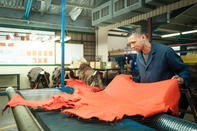When slaughtering and processing ostriches, it is important to evaluate the ostrich as a whole, because it has three main products - meat, skin and feathers - which determine the slaughter income.

Meat and skin make up to 70% of income for the ostrich farmer, while feathers make up the other 30% of the income. All three products are generated by the four main ostrich abattoirs in South Africa, but most feathers are sold and processed in Oudtshoorn.
Ostriches have a breeding season of eight months, followed by a four-month resting period from January to April or May. This means a seasonality to the availability of ostrich meat. To allow for year-round availability of ostrich meat, a technique of par-cooking ostrich meat has been developed. After par-cooking, the meat is frozen. Par-cooking ensures year-round availability and allows for quick preparation on thawing. Meat is also preserved in the form of biltong, a spicy dried meat product. Ostrich byproducts and off-cuts are also processed for pet food.
Ostrich skin is tanned to produce durable soft leather and feathers are cleaned, graded and dyed and made into fashion or household items.
Slaughtering of Ostriches
The ideal culling age of ostriches is 10 - 13 months or around 90 kg. This sized bird will produce a carcass of about 42 kg (46%). Of this, the meat yield - steak, fillet and trimmings - are about 27 kg. The main slaughtering season is from November to April, with a slow-down during the South African winter months.
During 2018, around 130 000 ostriches were slaughtered in South Africa.
Ostrich Abattoirs in South Africa
The first ostrich abattoir in South Africa started operating in 1950 and in 1993 the first abattoir for the export of ostrich to Europe was built.
According to the Department of Agriculture, Forestry and Fisheries (DAFF) there are five EU-approved ostrich abattoirs in South Africa - Klein Karoo International with facilities in Oudtshoorn, Swellendam and Graaff Reinet, also Grahamstown Ostrich, Makwe/Oryx, Mosstrich (Mossel Bay) and Roelcor (Malmesbury).
Two abattoirs, Klein Karoo International in Oudtshoorn, and Mossel Bay-based Mosstrich account for the bulk of ostrich slaughtering and processing in South Africa.
By Marinda Louw